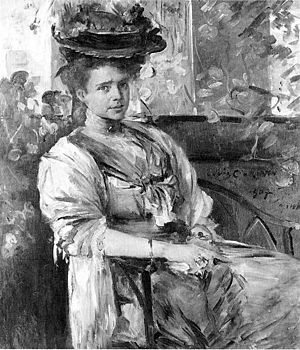Marg Moll facts for kids
Quick facts for kids
Marg Moll
|
|
|---|---|

Portrait of Margarethe Moll (1907)
by Lovis Corinth |
|
| Born |
Margarethe Haeffner
August 2, 1884 Mühlhausen, Germany
|
| Died | March 15, 1977 (aged 92) Munich, Germany
|
| Nationality | German |
| Education | Stadelsches Institut, Frankfurt; Académie Matisse, Paris |
| Known for | Sculpture |
| Spouse(s) | Oskar Moll |
Marg Moll (born Margarethe Haeffner; August 2, 1884 – March 15, 1977) was a German artist. She was a talented sculptor, painter, and writer.
Marg Moll was greatly inspired by the famous artist Henri Matisse. She spent her life creating art in his style. However, her modern art was sometimes destroyed and criticized by the Nazis. They did not like modern art. Marg was known for her strong support of Matisse. She also lived in an "ultra-modern house" in Berlin. This house was designed by Hans Scharoun, a German architect. He is famous for designing the Berlin Philharmonic concert hall.
Marg Moll's Life Story
Marg Moll was born in Mühlhausen, Germany. She started her art studies early. From 1903 to 1905, she studied at the Stadelsches Institut in Frankfurt am Main. She also learned from painter Hans Volker in Wiesbaden. Later, she studied painting in Bavaria with Oskar Moll. He was a professor and director at the Breslau Academy. Marg also learned sculpture from Louise Schmidt in Frankfurt am Main. In 1905, she traveled to Rome. From 1906 to 1907, she studied at Lovis Corinth's school for women in Berlin.
Margarethe married Oskar Moll. She became known as the "Director's Wife" because of her husband's important job. From 1907 to 1908, she studied at Académie Matisse in Paris. In 1908, she and Oskar started the Matisse School in Paris. They wanted to teach and share modern art styles, including Matisse's ideas. The Molls met Henri Matisse in 1908. That same year, Matisse painted a portrait of Marg. This painting is now in the National Gallery in London. When she began working with Matisse, Marg focused more on sculpture. She became very skilled and used many different materials.
The Molls had two daughters. Melita was born in 1908, and Brigitte was born in 1918. Marg lived in several cities during her life. She lived in Berlin from 1908 to 1919. Then she moved to Breslau in 1919 and stayed there until 1932. In 1934, she returned to Berlin. She lived there through World War II. Her family had to hide from the Nazis during the war. In 1943, the Molls built a house in Berlin. It was designed by the German architect Hans Scharoun. They filled their home with paintings by famous artists like Matisse, Fernand Léger, Georges Braque, and Pablo Picasso. Sadly, their home and many of her artworks were destroyed by bombs in Berlin in 1943. After Oskar died in 1947, Marg traveled around Europe and the United States. After 1952, she lived in Düsseldorf and Munich.
Marg Moll's Art Style
Marg Moll painted and sculpted throughout her life. Her sculpting style changed over time. At first, it was like Matisse's art, showing figures. Later, it became more modern, similar to the works of Constantin Brâncuși. Her art included different German styles, such as Expressionism and Bauhaus. She learned about these styles as the wife of Oskar Moll, who directed the Breslau Academy.
In 1928, Marg took an Eheferien. This is a German word for a "vacation from marriage." She went to Paris to finish some of her artworks. She wrote about this in her notes. Marg wanted her art to be seen separately from her husband's. But sometimes, they did show their works together. Her first art shows were with other artists. She exhibited with the Novembergruppe in Berlin. In 1931, she showed her work with Oskar Schlemmer at the Galerie Flechtheim. Museums across Germany bought her artworks. However, many of them were later removed and destroyed by the Nazis. This was part of Hitler's campaign against what he called "degenerate art." One of her sculptures, The Dancer, was found in ruins. It was discovered during digging for a new train station in Berlin. Ten other artworks were found with it. Marg Moll's sculpture is now shown at Berlin's Neues Museum in Germany.
Awards and Lasting Impact
After her husband died in 1947, Marg Moll showed her art many times. She traveled to the United States. There, she was recognized as an artist who helped promote modern art in Germany and worldwide. In 1950, she met the sculptor Henry Moore. In 1951, she joined the Women's International Art Club in London and received a medal. She also continued to work with GEDOK. This organization helped female artists show their work freely from 1930 to 1970. She was given a Groupe 1940 medal in Paris. When she was 70, she gave lectures at Wayne State University in Detroit. By the 1950s, her artworks were being shown alongside her husband's paintings. Marg Moll passed away in Munich in 1977.

